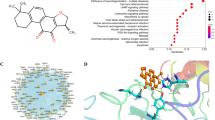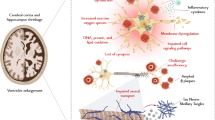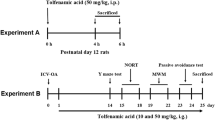Abstract
Glycogen synthase kinase-3β (GSK-3β) is a key element to phosphorylate tau and form neurofibrillary tangles (NFTs) found in tauopathies including Alzheimer’s disease (AD). A current topic for AD therapy is focused upon how to prevent tau phosphorylation. In the present study, PKCε activated Akt and inactivated GSK-3β by directly interacting with each protein. Inhibition of protein tyrosine phosphatase 1B (PTP1B), alternatively, caused an enhancement in the tyrosine phosphorylation of insulin receptor substrate 1 (IRS-1), allowing activation of Akt through a pathway along an IRS-1/phosphatidylinositol 3 kinase (PI3K)/3-phosphoinositide-dependent protein kinase-1 (PDK1)/Akt axis, to phosphorylate and inactivate GSK-3β. Combination of PKCε activation and PTP1B inhibition more sufficiently activated Akt and inactivated GSK-3β than each independent treatment, to suppress amyloid β (Aβ)-induced tau phosphorylation and ameliorate spatial learning and memory impairment in 5xFAD transgenic mice, an animal model of AD. This may represent an innovative strategy for AD therapy.







Similar content being viewed by others
References
Alonso A, Zaidi T, Novak M, Grundke-Iqbal I, Iqbal K (2001) Hyperphosphorylation induces self-assembly of tau into tangles of paired helical filaments/straight filaments. Proc Natl Acad Sci U S A 98(12):6923–6928
Hirokawa N, Takemura R (2005) Molecular motors and mechanisms of directional transport in neurons. Nat Rev Neurosci 6(3):201–214
Mandelkow E, von Bergen M, Biernat J, Mandelkow EM (2007) Structural principles of tau and the paired helical filaments of Alzheimer's disease. Brain Pathol 17(1):83–90
Trinczek B, Ebneth A, Mandelkow EM, Mandelkow E (1999) Tau regulates the attachment/detachment but not the speed of motors in microtubule-dependent transport of single vesicles and organelles. J Cell Sci 112(Pt14):2355–2367
Garcia ML, Cleveland DW (2001) Going new places using an old MAP: tau, microtubules and human neurodegenerative disease. Curr Opin Cell Biol 13(1):41–48
Binder LI, Guillozet-Bongaarts AL, Garcia-Sierra F, Berry RW (2005) Tau, tangles, and Alzheimer's disease. Biochim Biophys Acta 1739(2–3):216–223
Cuchillo-Ibanez I, Seereeram A, Byers HL, Leung KY, Ward MA, Anderton BH, Hanger DP (2008) Phosphorylation of tau regulates its axonal transport by controlling its binding to kinesin. FASEB J 22(9):3186–3195
Drubin DG, Kirschner MW (1986) Tau protein function in living cells. J Cell Biol 103(6 Pt2):2739–2746
Braak H, Braak E (1991) Neuropathological stageing of Alzheimer-related changes. Acta Neuropathol 82(4):239–259
Selkoe DJ (1986) Altered structural proteins in plaques and tangles: what do they tell us about the biology of Alzheimer’s disease? Neurobiol Aging 7(6):425–432
Ballatore C, Lee VM, Trojanowski JQ (2007) Tau-mediated neurodegeneration in Alzheimer’s disease and related disorders. Nat Rev Neurosci 8(9):663–672
Ma QL, Yang F, Rosario ER, Ubeda OJ, Beech W, Gant DJ, Chen PP, Hudspeth B et al (2009) β-amyloid oligomers induce phosphorylation of tau and inactivation of insulin receptor substrate via c-Jun N-terminal kinase signaling: suppression by omega-3 fatty acids and curcumin. J Neurosci 29(28):9078–9089
Hurtado DE, Molina-Porcel L, Iba M, Aboagye AK, Paul SM, Trojanowski JQ, Lee VM (2010) Aβ accelerates the spatiotemporal progression of tau pathology and augments tau amyloidosis in an Alzheimer mouse model. Am J Pathol 177(4):1977–1988
Héraud C, Goufak D, Ando K, Leroy K, Suain V, Yilmaz Z, De Decker R, Authelet M et al (2014) Increased misfolding and truncation of tau in APP/PS1/tau transgenic mice compared to mutant tau mice. Neurobiol Dis 62:100–112
Stancu IC, Ris L, Vasconcelos B, Marinangeli C, Goeminne L, Laporte V, Haylani LE, Couturier J et al (2014) Tauopathy contributes to synaptic and cognitive deficits in a murine model for Alzheimer's disease. FASEB J 28(6):2620–2631
Patrick GN, Zukerberg L, Nikolic M, de la Monte S, Dikkes P, Tsai LH (1999) Conversion of p35 to p25 deregulates Cdk5 activity and promotes neurodegeneration. Nature 402(6762):615–622
Jeganathan S, Hascher A, Chinnathambi S, Biernat J, Mandelkow EM, Mandelkow E (2008) Proline-directed pseudo-phosphorylation at AT8 and PHF1 epitopes induces a compaction of the paperclip folding of Tau and generates a pathological (MC-1) conformation. J Biol Chem 283(46):32066–32076
Pei JJ, Björkdahl C, Zhang H, Zhou X, Winblad B (2008) p70 S6 kinase and tau in Alzheimer's disease. J Alzheimers Dis 14(4):385–392
Takashima A (2006) GSK-3 is essential in the pathogenesis of Alzheimer's disease. J Alzheimers Dis 9(3 Suppl):309–317
Tsuchiya A, Kanno T, Nagaya H, Shimizu T, Tanaka A, Nishizaki T (2014) PTP1B inhibition causes Rac1 activation by enhancing receptor tyrosine kinase signaling. Cell Physiol Biochem 33(4):1097–1105
Kanno T, Yamamoto H, Yaguchi T, Hi R, Mukasa T, Fujikawa H, Nagata T, Yamamoto S et al (2006) The linoleic acid derivative DCP-LA selectively activates PKC-ε, possibly binding to the phosphatidylserine binding site. J Lipid Res 47(6):1146–1156
Shimizu T, Kanno T, Tanaka A, Nishizaki T (2011) α, β-DCP-LA selectively activates PKC-ε and stimulates neurotransmitter release with the highest potency among 4 diastereomers. Cell Physiol Biochem 27(2):149–158
Wada A (2009) Lithium and neuropsychiatric therapeutics: neuroplasticity via glycogen synthase kinase-3β, β-catenin, and neurotrophin cascades. J Pharmacol Sci 110(1):14–28
Tsuchiya A, Kanno T, Nishizaki T (2013) Diacylglycerol promotes GLUT4 translocation to the cell surface in a PKCε-dependent and PKCλ/ι and -ζ-independent manner. Life Sci 93(5–6):240–246
Nagata T, Tomiyama T, Mori H, Yaguchi T, Nishizaki T (2010) DCP-LA neutralizes mutant amyloid β peptide-induced impairment of long-term potentiation and spatial learning. Behav Brain Res 206(1):151–154
Nagata T, Yamamoto S, Yaguchi T, Iso H, Tanaka A, Nishizaki T (2005) The newly synthesized linoleic acid derivative DCP-LA ameliorates memory deficits in animal models treated with amyloid-β peptide and scopolamine. Psychogeriatrics 5(4):122–126
Yaguchi T, Nagata T, Mukasa T, Fujikawa H, Yamamoto H, Yamamoto S, Iso H, Tanaka A et al (2006) Linoleic acid derivative DCP-LA improves learning impairment in SAMP8. Neuroreport 17(1):105–108
Oakley H, Cole SL, Logan S, Maus E, Shao P, Craft J, Guillozet-Bongaarts A, Ohno M et al (2006) Intraneuronal β-amyloid aggregates, neurodegeneration, and neuron loss in transgenic mice with five familial Alzheimer's disease mutations: potential factors in amyloid plaque formation. J Neurosci 26(40):10129–10140
Rizzo G, Martinelli P, Manners D, Scaglione C, Tonon C, Cortelli P, Malucelli E, Capellari S et al (2008) Diffusion-weighted brain imaging study of patients with clinical diagnosis of corticobasal degeneration, progressive supranuclear palsy and Parkinson's disease. Brain 131(Pt10):2690–2700
Nussbaum JM, Seward ME, Bloom GS (2013) Alzheimer disease: a tale of two prions. Prion 7(1):14–19
Duyckaerts C (2011) Tau pathology in children and young adults: can you still be unconditionally baptist. Acta Neuropathol 121(2):145–147
Mukaetova-Ladinska EB, Garcia-Siera F, Hurt J, Gertz HJ, Xuereb JH, Hills R, Brayne C, Huppert FA et al (2000) Staging of cytoskeletal and β-amyloid changes in human isocortex reveals biphasic synaptic protein response during progression of Alzheimer's disease. Am J Pathol 157(2):623–636
Kanno T, Tsuchiya A, Shimizu T, Nakao S, Tanaka A, Nishizaki T (2013) Effects of newly synthesized DCP-LA-phospholipids on protein kinase C and protein phosphatases. Cell Physiol Biochem 31(4–5):555–564
Bayascas JR, Alessi DR (2005) Regulation of Akt/PKB Ser473 phosphorylation. Mol Cell 18(2):143–145
Gao T, Furnari F, Newton AC (2005) PHLPP: a phosphatase that directly dephosphorylates Akt, promotes apoptosis, and suppresses tumor growth. Mol Cell 18(1):13–24
Razmara M, Heldin CH, Lennartsson J (2013) Platelet-derived growth factor-induced Akt phosphorylation requires mTOR/Rictor and phospholipase C-γ1, whereas S6 phosphorylation depends on mTOR/Raptor and phospholipase D. Cell Commun Signal 11(1):3
Salminen A, Ojala J, Kaarniranta K, Hiltunen M, Soininen H (2011) Hsp90 regulates tau pathology through co-chaperone complexes in Alzheimer's disease. Prog Neurobiol 93(1):99–110
Wischik CM, Harrington CR, Storey JM (2014) Tau-aggregation inhibitor therapy for Alzheimer's disease. Biochem Pharmacol 88(4):529–539
Graham DL, Gray AJ, Joyce JA, Yu D, O'Moore J, Carlson GA, Shearman MS, Dellovade TL et al (2014) Increased O-GlcNAcylation reduces pathological tau without affecting its normal phosphorylation in a mouse model of tauopathy. Neuropharmacology 79:307–313
Ballatore C, Brunden KR, Piscitelli F, James MJ, Crowe A, Yao Y, Hyde E, Trojanowski JQ et al (2010) Discovery of brain-penetrant, orally bioavailable aminothienopyridazine inhibitors of tau aggregation. J Med Chem 53(9):3739–3747
Brunden KR, Ballatore C, Lee VM, Smith AB 3rd, Trojanowski JQ (2012) Brain-penetrant microtubule-stabilizing compounds as potential therapeutic agents for tauopathies. Biochem Soc Trans 40(4):661–666
Tanaka A, Nishizaki T (2003) The newly synthesized linoleic acid derivative FR236924 induces a long-lasting facilitation of hippocampal neurotransmission by targeting nicotinic acetylcholine receptors. Bioorg Med Chem Lett 13(6):1037–1040
Yamamoto S, Kanno T, Nagata T, Yaguchi T, Tanaka A, Nishizaki T (2005) The linoleic acid derivative FR236924 facilitates hippocampal synaptic transmission by enhancing activity of presynaptic α7 acetylcholine receptors on the glutamatergic terminals. Neuroscience 130(1):207–213
Kanno T, Tanaka A, Nishizaki T (2012) Linoleic acid derivative DCP-LA stimulates vesicular transport of α7 ACh receptors towards surface membrane. Cell Physiol Biochem 30(1):75–82
Kanno T, Tsuchiya A, Tanaka A, Nishizaki T (2013) The linoleic acid derivative DCP-LA increases membrane surface localization of the α7 ACh receptor in a protein 4.1N-dependent manner. Biochem J 450(2):303–309
Kanno T, Yaguchi T, Nagata T, Tanaka A, Nishizaki T (2009) DCP-LA stimulates AMPA receptor exocytosis through CaMKII activation due to PP-1 inhibition. J Cell Physiol 221(1):183–188
Conflict of interest
The authors state that there are no actual or potential conflicts of interest.
Author information
Authors and Affiliations
Corresponding author
Electronic supplementary material
Below is the link to the electronic supplementary material.
Supplementary Fig. 1
(PDF 198 kb)
Supplementary Fig. 2
(PDF 64 kb)
Supplementary Fig. 3
(PDF 68 kb)
Supplementary Fig. 4
(PDF 285 kb)
Supplementary Fig. 5
(PDF 135 kb)
Supplementary Fig. 6
(PDF 220 kb)
Supplementary Fig. 7
(PDF 81 kb)
Rights and permissions
About this article
Cite this article
Kanno, T., Tsuchiya, A., Tanaka, A. et al. Combination of PKCε Activation and PTP1B Inhibition Effectively Suppresses Aβ-Induced GSK-3β Activation and Tau Phosphorylation. Mol Neurobiol 53, 4787–4797 (2016). https://doi.org/10.1007/s12035-015-9405-x
Received:
Accepted:
Published:
Issue Date:
DOI: https://doi.org/10.1007/s12035-015-9405-x




